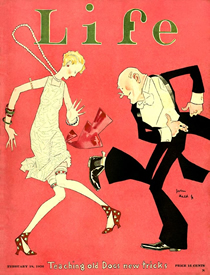 No matter how you try to capture the spirit of the Roaring Twenties or the Jazz Age, nothing looms larger in a discussion of that fast-paced decade than the Great Crash of 1929. The collapse of Wall Street stock prices on “Black Tuesday,” October 29, 1929 was unprecedented and devastating. There were many underlying causes of the Great Depression that subsequently enveloped the industrialized world during the 1930s, but any serious discussion of that period must begin with the stock market crash. What had looked to many like an American future of almost unlimited prosperity rooted in a new mass consumer culture was now suddenly appearing quite vulnerable. What had seemed like a generally progressive and sound system of balanced, business-friendly U.S. government policies now appeared wildly out of control. There had always been some deep problems in the American economy during the 1920s –widespread poverty, depressed prices in agriculture, dangerously over-extended credit– but most of those ills had been covered up at least in the popular culture by the kind of glamour epitomized (and gently mocked) in F. Scott Fitzgerald’s famous novel, The Great Gatsby (1925). After October 1929, however, there was much less glamour to celebrate. Between 1929 and 1933, the average price of blue chip stocks declined by 90 percent. Unemployment, which had been hovering around 3 percent, rose to a reported 25 percent. Even more revealing, investment dollars and available credit dried up almost completely –by some accounts, declining by nearly 98 percent in four years. That is why American families such as Russell Baker’s sometimes broke apart and struggled to redefine what for them had become a very fragile American Dream.
No matter how you try to capture the spirit of the Roaring Twenties or the Jazz Age, nothing looms larger in a discussion of that fast-paced decade than the Great Crash of 1929. The collapse of Wall Street stock prices on “Black Tuesday,” October 29, 1929 was unprecedented and devastating. There were many underlying causes of the Great Depression that subsequently enveloped the industrialized world during the 1930s, but any serious discussion of that period must begin with the stock market crash. What had looked to many like an American future of almost unlimited prosperity rooted in a new mass consumer culture was now suddenly appearing quite vulnerable. What had seemed like a generally progressive and sound system of balanced, business-friendly U.S. government policies now appeared wildly out of control. There had always been some deep problems in the American economy during the 1920s –widespread poverty, depressed prices in agriculture, dangerously over-extended credit– but most of those ills had been covered up at least in the popular culture by the kind of glamour epitomized (and gently mocked) in F. Scott Fitzgerald’s famous novel, The Great Gatsby (1925). After October 1929, however, there was much less glamour to celebrate. Between 1929 and 1933, the average price of blue chip stocks declined by 90 percent. Unemployment, which had been hovering around 3 percent, rose to a reported 25 percent. Even more revealing, investment dollars and available credit dried up almost completely –by some accounts, declining by nearly 98 percent in four years. That is why American families such as Russell Baker’s sometimes broke apart and struggled to redefine what for them had become a very fragile American Dream.
Online Textbook Resources
Jazz Age from Digital History (Mintz and McNeil)
Selected Timelines
American Literature & Events: 1920s (Donna Campbell / Washington State)
Featured Videos